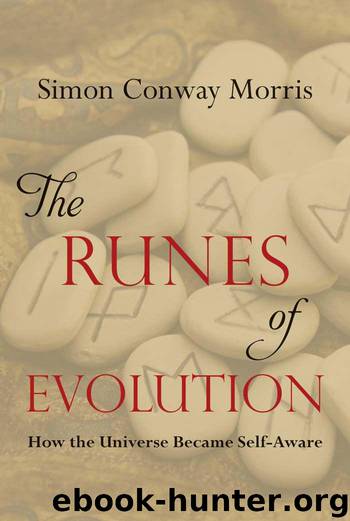The Runes of Evolution: How the Universe became Self-Aware by Simon Conway Morris

Author:Simon Conway Morris [Morris, Simon Conway]
Language: eng
Format: epub, mobi
Publisher: Templeton Press
Published: 2015-06-30T00:00:00+00:00
FOOLING AROUND
The exuberance of play—sometimes its edginess and irony, not to mention being helpless with laughter (a perhaps all-too-common occurrence in reading this book)—remind us that at heart the world is deeply comic. Play is also subversive. As Gordon Burghardt remarks, the rough-and-tumble play of children “is largely ignored in the child play literature . . . This may be because it is often too rambunctious for researchers and does not seem to be so connected with the cognitive skills that ‘good’ play is thought to instill.”197 Such is evident from the manic attempts of ambitious parents to ensure that every purchased game is “educational” before leading them to a sanitized play park where the first graze on the knee ensures highly remunerative litigation. Burghardt reminds us how all too often a “misunderstanding and mischaracterization of rough-and-tumble play by teachers and daycare workers . . . who are often sedentary females, leads to prohibitions against it in many contexts.”198 No matter—in a twinkling of an eye their young charges will be bungee jumping, surfing a widowmaker, climbing granite peaks without ropes, wingsuiting, and freediving. What other species would think these are sensible things to do?
This catalogue of adrenalin-packed activities is one more hint that humans may be a whisker away from other mammals, but we now find themselves in new worlds. Even so the evolutionary range of play among mammals remains striking. Curiously among them, play (and here it is customary to consider it as either object-based, locomotory, or social) might be diagnostic, but some groups, such as the xenarthrans, are pretty quiescent. As Gordon Burghardt also mentions, “the wide variation in the ubiquity and complexity of play within these [mammalian] orders suggests play evolved and was later lost or greatly modified repeatedly during the evolution of placental mammals.”199 Just so, but what really matters is whether animal play has deep phylogenetic roots. Did it emerge from the mists of time when the first worm frolicked, or was it invented multiple times? As far as the mammals are concerned, “boxing” kangaroos,200 and more tentative evidence for platypus play,201 suggests that their clowning had already started in the Mesozoic. Much more likely is that complex and sophisticated play evolved multiple times in the mammals.202 It certainly has in the birds.
As Judy Diamond and Alan Bond note in their overview,203 “Social play in birds shares many characteristics with social play in mammals,”204 but it is clearly convergent. For the most part it is associated with birds with a reputation for intelligence, notably the corvids, hornbills, and parrots. Among the last group, particularly striking is the New Zealand kea,205 which not only epitomizes the convergence in terms of categories of play (such as mock wrestling, chasing, and tug-of-war), but as Diamond and Bond note, traits of juvenile delinquency. Not only do “young keas display a seemingly endless appetite for destroying large objects,” 206 but when night falls the young hang around for “play and aggression. In one late-night interaction, for example, a sizable
Download
The Runes of Evolution: How the Universe became Self-Aware by Simon Conway Morris.mobi
This site does not store any files on its server. We only index and link to content provided by other sites. Please contact the content providers to delete copyright contents if any and email us, we'll remove relevant links or contents immediately.
| Cell Biology | Developmental Biology |
| Entomology | Marine Biology |
| Microbiology | Molecular Biology |
| Biostatistics |
Sapiens: A Brief History of Humankind by Yuval Noah Harari(14209)
The Tidewater Tales by John Barth(12594)
Mastermind: How to Think Like Sherlock Holmes by Maria Konnikova(7195)
Do No Harm Stories of Life, Death and Brain Surgery by Henry Marsh(6875)
The Thirst by Nesbo Jo(6806)
Why We Sleep: Unlocking the Power of Sleep and Dreams by Matthew Walker(6595)
Life 3.0: Being Human in the Age of Artificial Intelligence by Tegmark Max(5446)
Sapiens by Yuval Noah Harari(5280)
The Longevity Diet by Valter Longo(5006)
The Body: A Guide for Occupants by Bill Bryson(4950)
The Rules Do Not Apply by Ariel Levy(4822)
The Immortal Life of Henrietta Lacks by Rebecca Skloot(4500)
Animal Frequency by Melissa Alvarez(4382)
Why We Sleep by Matthew Walker(4340)
The Hacking of the American Mind by Robert H. Lustig(4302)
Yoga Anatomy by Kaminoff Leslie(4288)
All Creatures Great and Small by James Herriot(4211)
Double Down (Diary of a Wimpy Kid Book 11) by Jeff Kinney(4175)
Barron's AP Biology by Goldberg M.S. Deborah T(4080)
